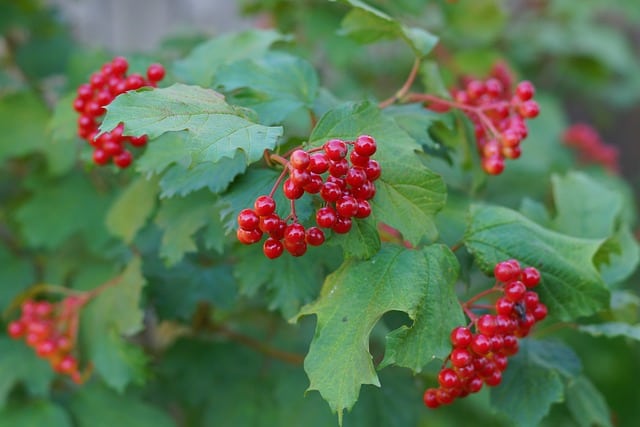Viburnums are a group of shrubs and small trees that are widely grown in gardens and landscapes for their attractive foliage, showy flowers, and sometimes colorful berries.
However, these plants are not immune to diseases and pests, and one of the most common problems that gardeners face is brown spots on viburnum leaves. These unsightly spots can be caused by a variety of factors, including fungal diseases, bacterial infections, insect infestations, and environmental stressors.
Recognizing brown spots on viburnum leaves is the first step in preventing and treating this problem. The spots may appear as small, circular lesions or irregularly shaped patches on the leaves, and they may be brown, black, or yellow in color.
In some cases, the spots may be accompanied by other symptoms, such as wilting, yellowing, or dropping of the leaves. It is important to note that not all brown spots on viburnum leaves are caused by the same factors, and accurate identification of the problem is essential for effective treatment.
Common causes of brown spots on viburnum leaves include fungal diseases, such as leaf spot, powdery mildew, and anthracnose, as well as bacterial infections, such as bacterial leaf spot.
Insects, such as spider mites and scale insects, can also cause brown spots on viburnum leaves by feeding on the plant’s tissues. Environmental factors, such as drought, heat stress, and poor soil drainage, can also contribute to the development of brown spots on viburnum leaves.
Key Takeaways
- Brown spots on viburnum leaves can be caused by a variety of factors, including fungal diseases, bacterial infections, insect infestations, and environmental stressors.
- Accurate identification of the problem is essential for effective treatment.
- Preventing brown spots on viburnum leaves involves maintaining good plant health, providing adequate water and nutrients, and promptly treating any signs of disease or pest infestation.
Also see:
- Brown Spots on Underside of Monstera Leaves
- Brown Spots on Syngonium Leaves
- Brown Spots on Spinach Leaves
Recognizing Brown Spots on Viburnum Leaves
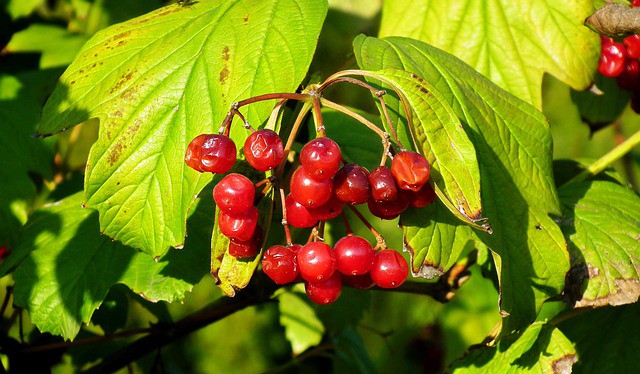
Viburnum plants are often grown in gardens for their beautiful flowers and pretty-looking foliage. However, if you notice brown spots on the leaves, it may indicate a problem. Here’s what you need to know to recognize brown spots on viburnum leaves.
1. Symptoms of Brown Spots on Viburnum Leaves
Brown spots on viburnum leaves are a common symptom of fungal diseases. These spots may be circular or angular in shape, and they can vary in size. Initially, the spots may appear yellow or pale green, but they will eventually turn reddish-brown or grayish-brown as they age.
Sometimes, the edges of the spots may be feathery or fuzzy.
2. Infected Leaves
In addition to brown spots, infected leaves may also show other symptoms. For example, young leaves may become crinkled or distorted. If the infection is severe, the leaves may turn completely brown and fall off the plant.
3. Angular and Dry Spots
Some fungal diseases that cause brown spots on viburnum leaves may produce angular spots. These spots may have a distinct shape, with straight edges that form angles. Additionally, the spots may feel dry to the touch, and they may crack or split as they age.
4. Reddish-Brown Spots
If the brown spots on your viburnum leaves have a reddish tint, it may indicate a specific type of fungal disease. Anthracnose is a fungal disease that can cause reddish-brown spots on viburnum leaves, along with other symptoms like defoliation and dieback.
5. Grayish-Brown Spots
Another fungal disease that can cause brown spots on viburnum leaves is downy mildew. This disease typically produces grayish-brown spots that may have a fuzzy appearance. If you notice grayish-brown spots on your viburnum leaves, it’s important to take action quickly to prevent the disease from spreading.
By recognizing the symptoms of brown spots on viburnum leaves, you can take steps to prevent the spread of fungal diseases and keep your plants healthy.
Brown Spots on Viburnum Leaves – 9 Common Problems
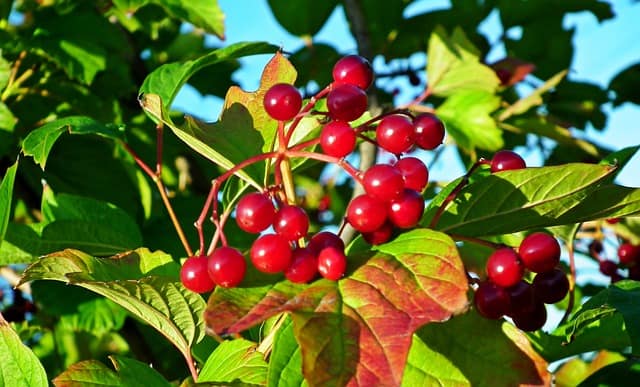
Viburnum plants are susceptible to a variety of diseases and pests that can cause brown spots on the leaves. Here are some of the most common causes of brown spots on viburnum leaves:
1. Fungal Leaf Spots
Fungal leaf spots are caused by various types of fungi, including Cercospora, Phoma, and Phyllosticta species. These fungal leaf spots on viburnum typically are angular to irregular-shaped, and the leaf tissue in the spots is sunken and dry.
Spots may begin small but enlarge or merge and may be reddish to grayish brown. Fungi can thrive in wet or humid conditions, making it important to keep the plant’s leaves dry to prevent these spots from forming.
2. Algal Leaf Spot
Algal leaf spot is caused by a type of algae that thrives in moist, shady conditions. Algal leaf spots appear as small, dark spots on the leaves of the plant. If left untreated, the spots will eventually turn brown and cause the leaves to fall off. To treat algal leaf spot, remove affected leaves and dispose of them properly.
3. Bacterial Leaf Spot
Bacterial leaf spot is caused by the bacteria Xanthomonas campestris. The spots are small, water-soaked, and circular, with a yellow halo. As the spots enlarge, they become brown and necrotic. Bacterial leaf spot is more common in warm, humid weather, and can be spread through contaminated pruning tools or splashing water.
4. Canker Diseases
Canker diseases are caused by fungi or bacteria that infect the bark of the plant. The infected bark becomes sunken and discolored, and the cankers can girdle the branches and cause dieback. Armillaria root rot and botryosphaeria canker are two common canker diseases that affect viburnum plants.
5. Powdery Mildew and Downy Mildew
Powdery mildew and downy mildew are fungal diseases that can cause brown spots on viburnum leaves. Powdery mildew appears as a white or gray powder on the leaves, while downy mildew causes yellow or brown spots on the leaves.
These diseases thrive in humid conditions and can be prevented by keeping the plant’s leaves dry.
6. Rust
Rust is a fungal disease that can cause brown spots on viburnum leaves. The spots are usually small and circular, with a reddish-brown color. Rust can be prevented by keeping the plant’s leaves dry and removing infected leaves promptly.
7. Anthracnose
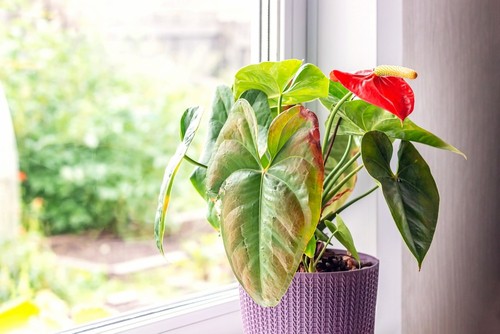
Anthracnose is a fungal disease that can cause brown spots on viburnum leaves. The spots are irregular in shape and may have a purple border. Anthracnose can be prevented by keeping the plant’s leaves dry and removing infected leaves promptly.
8. Cephaluros Virescens and Plasmopara Viburni
Cephaluros virescens and Plasmopara viburni are fungal diseases that can cause brown spots on viburnum leaves. The spots are usually small and circular, with a reddish-brown color. These diseases thrive in humid conditions and can be prevented by keeping the plant’s leaves dry.
9. Sunken Spots
Sunken spots on viburnum leaves can be caused by various diseases, including fungal leaf spots, bacterial leaf spot, and canker diseases. These spots are usually sunken and dry, with a reddish-brown color.
Overall, there are many different causes of brown spots on viburnum leaves, and it’s important to identify the specific disease or pest to effectively treat and prevent further damage to the plant.
Environmental Factors Influencing Brown Spots
Environmental factors can play a significant role in the development of brown spots on viburnum leaves. Understanding these factors can help gardeners take steps to prevent and manage this issue.
1. Moisture
Moist conditions can promote the growth of fungi that cause leaf spot diseases. Overhead irrigation and additional water can keep leaves wet, creating an environment that is conducive to fungal growth.
Fallen leaves can also provide a moist environment for fungi to thrive. Gardeners can prevent moisture buildup by avoiding overhead irrigation, removing fallen leaves, and providing adequate space between plants to promote air circulation.
2. Drought Stress
Drought stress can make plants more susceptible to disease and pest infestations. When plants are under drought stress, their leaves may become damaged or weakened, making them more vulnerable to fungal infections.
Gardeners can prevent drought stress by providing adequate water during dry periods and avoiding excessive pruning.
3. Mechanical Injury
Mechanical injury, such as damage from lawn mowers or pruning tools, can create wounds on viburnum leaves that make them more vulnerable to disease. Gardeners can prevent mechanical injury by using sharp, clean tools and avoiding pruning during wet weather.
4. Light and Temperature

Viburnums prefer cool, moist conditions and partial shade. When grown in full sun or warm, dry conditions, they may become stressed and more susceptible to disease. Gardeners can provide shade and ensure that plants are not exposed to excessively warm or dry conditions.
5. Air Circulation
Air circulation is important for preventing the buildup of moisture and reducing the risk of disease. Gardeners can provide adequate space between plants and avoid overcrowding to promote air circulation.
Preventing and Treating Brown Spots on Viburnum Leaves
Viburnums are woody shrubs that belong to the genus Viburnum and are commonly grown in gardens for their beautiful flowers. However, they are susceptible to various diseases that can cause brown spots on their leaves. The good news is that brown spots on viburnum leaves can be prevented and treated with proper care.
Preventing Brown Spots on Viburnum Leaves
The first step in preventing brown spots on viburnum leaves is to choose a species that is resistant to common viburnum diseases. Native species are often more resistant to diseases than non-native ones. It is also important to plant viburnums in well-drained soil and avoid overwatering.
Another way to prevent brown spots on viburnum leaves is to practice good horticultural practices. This includes pruning diseased or damaged stems and shoots, disposing of infected leaves and debris in the trash instead of compost pile, and avoiding mulching with pine needles or shoestrings.
Dog urine can also cause brown spots on viburnum leaves. To prevent this, train dogs to urinate in a designated area away from viburnum plants.
Treating Brown Spots on Viburnum Leaves
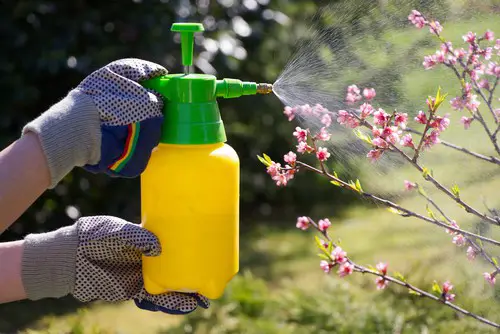
If brown spots on viburnum leaves have already developed, it is important to treat them promptly to prevent the disease from spreading. The first step is to identify the cause of the brown spots. Fungal diseases such as powdery mildew, leaf spot, and anthracnose are common causes of brown spots on viburnum leaves.
Once the cause has been identified, the appropriate fungicide can be applied according to label directions. Copper fungicides and sulfur are effective in treating fungal diseases on viburnums. Horticultural oil can also be used to control fungal diseases.
It is important to apply fungicides and horticultural oil to developing leaves and leaf veins to ensure that they are protected from the disease. Foliage applications should be made at regular intervals as recommended by the label directions.
If the brown spots are caused by a contagious disease such as Armillaria, it may be necessary to remove the infected plant and dispose of it properly. Diseased plants should not be pruned during wet conditions as this can spread the disease.
Frequently Asked Questions
What causes brown spots on viburnum leaves?
Brown spots on viburnum leaves can be caused by various factors, including fungal diseases, bacterial infections, and environmental stressors.
Fungal leaf spots typically occur during warm, moist summer months and initially will occur on older foliage. The disease anthracnose, caused by Colletotrichum species, appears as black, sunken lesions.
How can I prevent brown spots on viburnum leaves?
The key to preventing leaf spot diseases where leaves turn brown on viburnum is to keep leaves relatively dry. Do not use overhead irrigation and leave sufficient space between your plants for air to pass through.
Additionally, avoid overcrowding and overfertilizing your plants, as this can lead to stress and make them more susceptible to disease.
What are the common diseases that cause brown spots on viburnum leaves?
Common diseases that cause brown spots on viburnum leaves include fungal leaf spots, anthracnose, and mildew diseases. These diseases can cause brown spots on the leaves, as well as leaf discoloration, distortion, and defoliation.
What is the best way to treat brown spots on viburnum leaves?
The best way to treat brown spots on viburnum leaves depends on the specific disease causing the spots. Fungal diseases can often be treated with fungicides, while bacterial infections may require the use of antibiotics.
It is important to properly identify the disease before attempting to treat it, as using the wrong treatment can be ineffective and potentially harmful to the plant.
Are there any natural remedies to treat brown spots on viburnum leaves?
There are some natural remedies that may be effective in treating brown spots on viburnum leaves. These include using neem oil, a natural fungicide, or a mixture of baking soda and water to control fungal diseases.
Additionally, improving the plant’s growing conditions, such as providing adequate sunlight and soil drainage, can help prevent and treat disease.
How can I differentiate between different diseases that cause brown spots on viburnum leaves?
Differentiating between different diseases that cause brown spots on viburnum leaves can be challenging, as many diseases have similar symptoms. It is important to properly identify the disease before attempting to treat it.
Consulting with a professional or using a plant disease diagnostic tool can help identify the specific disease and guide treatment options.

Hey, I’m Lisa and I’ve been an avid gardener for over 30 years. I love writing, talking and living in the garden! Feel free to connect with me on my socials below

